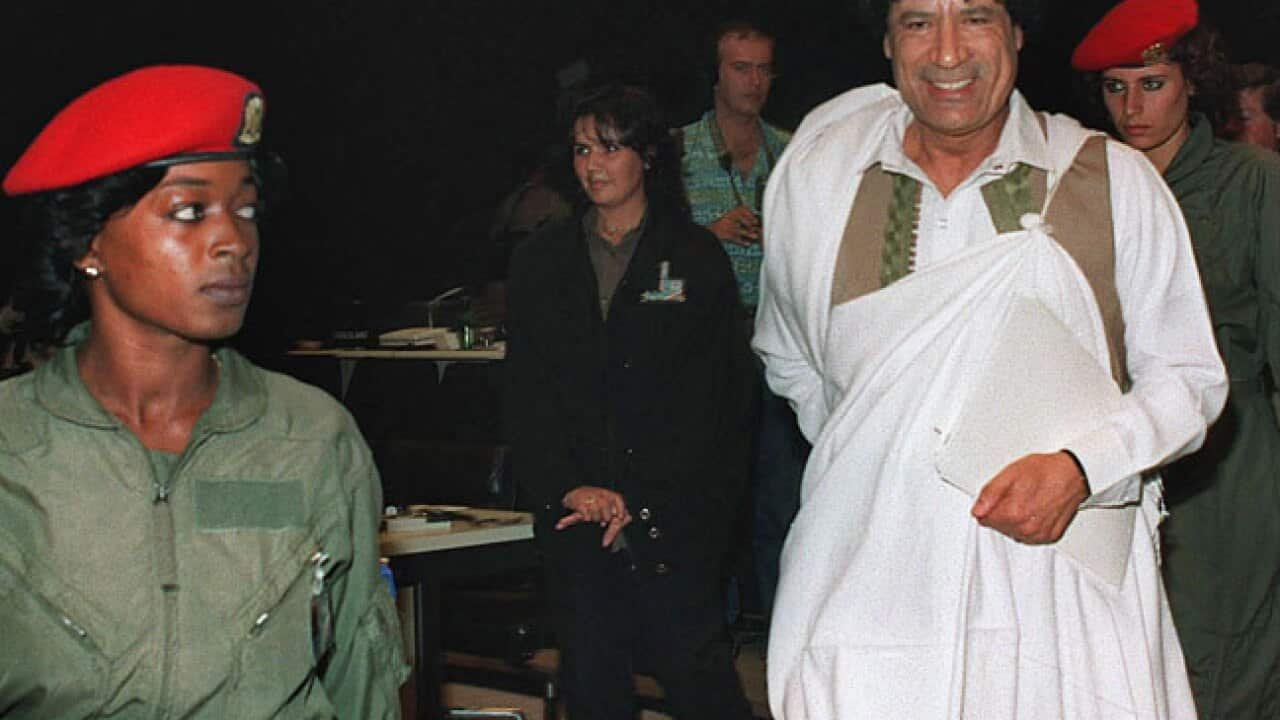He was scared of flying and slept in a tent, but as leader of one of Africa's wealthiest nations, Gaddafi was notorious for much more than his eccentric outfits.
Gaddafi was killed after an assualt on his brithtown of Sirte on October 20th, 2011 the Natinal Transition Council said.
SBS looks back at the life of the world's longest-serving leader.
Muammar Gaddafi was born to a desert Bedouin tribe in 1942. He started University studies but dropped out to join the Libyan military in 1961.
POLITICAL CAREER
He was the longest-serving leader in both Africa and the Arab world. At 27 years of age, he staged a successful, bloodless revolution in 1969 against Libya's King Idris.
Gaddafi never promoted himself to the rank of General after seizing power, as he says that Libya is "ruled by the people" and thus he needs no higher rank. There are even reports that he was inspired by Argentine Marxist revolutionary Che Guevara.
Gaddafi funded and armed many political groups, some said to be radical, who could prove their commitment to fighting Western imperialism. As a result, notable leaders who have since been convicted of war crimes were funded by Gaddafi, such as Liberian despot Charles Taylor and Sierra Leonean rebel commander Foday Sankoh.
He has also been linked to the verbal and financial support of groups including the IRA and Palestinian Liberation Organisation. Gaddafi's regime has often been criticised for political repression of its people, executing dissidents publically, as well as harbouring nuclear and chemical weapons. However in 2003 Gaddafi officially relinquished his supply of weapons of mass destruction.
US President Ronald Reagan called him a "mad dog" and ordered bombers to strike Libya's capital Tripoli in 1986.
Perhaps his most famous involvement in controversial affairs was the bombing. The international community shunned Libya for decades after Abdelbaset al-Megrahi masterminded the bombing of Pan Am flight 103 over the Scottish town of Lockerbie, killing 270 people. Gaddafi's regime eventually took responsibility for the attack, and paid compensation to the families of those who died. Al-Megrahi was controversally released in 2009.
'COMING IN FROM THE COLD'
The 1990s saw the leader attempt to mend ties with the West and other Arab leaders with whom he had a distant - often hostile - relationship. He made a series of policy decisions - such as the redistribution of oil wealth amongst Libyans - that improved his international standing, and met with a series of major world leaders.
He was elected Chairman of the Africa Union body in 2009, where he spoke of his dreams for a 'United States of Africa'.
He visited the United States for the first time in 2009 to address the United Nations. His speech went for over one and a half , where he criticised the UN for failing to prevent 65 wars, defending the Taliban and Somali pirates as a reaction to Western exploitation of their countries. A video of his UN address is available .
In January 2011 mass anti-government protests and a political uprising erupted in Libya, spreading quickly around the country.
PERSONAL LIFE
Gaddafi was married to Safia Farfash, a former nurse and his second wife. He has eight biological children, and two adopted children.
Gaddafi claimed that an unknown adopted daughter of his called Hanna was killed in the US bombing of Libya.
His family are rumoured to have a personal fortune of roughly $US60 billion.
QUIRKY FACTS
Gaddafi had a fear of flying over water. He previously did not travel anywhere without his Ukrainian nurse, who was evacuated on February 28 due to the political unrest.
He had an all-female contingent of 30-40 bodyguards, known as the Amazonian Guard. The women reportedly had to be virgins to qualify for duty and were personally selected by Gaddafi. He slept in a Bedouin tent at home and abroad, guarded by the Amazonian Guard, according to Al Jjazeera.
Gaddafi was extremely concerned with his public image, and ordered the assassination of dozens of his critics around the world in the 1970s and '80s. His dress sense was flamboyant and he was often seen in his characteristic safari suits and opaque sunglasses. He was also famous for his long, often rambling speeches that were often unscripted.









